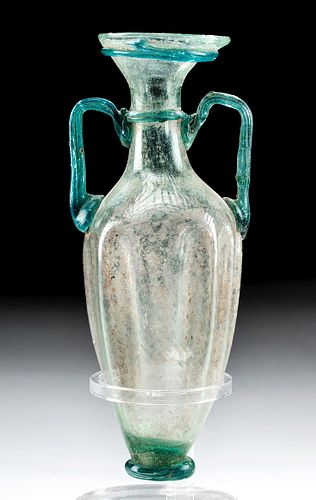Fine Roman Glass Amphoriskos w/ Trail Handles
Lot 46a
About Seller
Artemis Gallery
686 S Taylor Ave, Ste 106
Louisville, CO 80027
United States
Selling antiquities, ancient and ethnographic art online since 1993, Artemis Gallery specializes in Classical Antiquities (Egyptian, Greek, Roman, Near Eastern), Asian, Pre-Columbian, African / Tribal / Oceanographic art. Our extensive inventory includes pottery, stone, metal, wood, glass and textil...Read more
Categories
Estimate:
$2,000 - $3,000
Absentee vs Live bid
Two ways to bid:
- Leave a max absentee bid and the platform will bid on your behalf up to your maximum bid during the live auction.
- Bid live during the auction and your bids will be submitted real-time to the auctioneer.
Bid Increments
| Price | Bid Increment |
|---|---|
| $0 | $25 |
| $300 | $50 |
| $1,000 | $100 |
| $2,000 | $250 |
| $5,000 | $500 |
| $10,000 | $1,000 |
| $20,000 | $2,500 |
| $50,000 | $5,000 |
| $100,000 | $10,000 |
| $200,000 | $20,000 |
About Auction
By Artemis Gallery
Feb 13, 2020
Set Reminder
2020-02-13 10:00:00
2020-02-13 10:00:00
America/New_York
Bidsquare
Bidsquare : Exceptional Antiquities, Asian, Ethnographic
https://www.bidsquare.com/auctions/artemis-gallery/exceptional-antiquities-asian-ethnographic-4848
An important one-day auction featuring museum-worthy examples of Egyptian, Greek, Roman, Etruscan, Near Eastern, Far East / Asian, Pre-Columbian, African / Tribal, Oceanic, Native American, Spanish Colonial, Russian, Fossils, Ancient Jewelry, Fine Art, so much more! Artemis Gallery info@artemisgallery.com
An important one-day auction featuring museum-worthy examples of Egyptian, Greek, Roman, Etruscan, Near Eastern, Far East / Asian, Pre-Columbian, African / Tribal, Oceanic, Native American, Spanish Colonial, Russian, Fossils, Ancient Jewelry, Fine Art, so much more! Artemis Gallery info@artemisgallery.com
- Lot Description
Roman, Imperial Period, ca. 3rd to 4th century CE. A gorgeous example of a pattern-molded amphoriskos formed from nearly transparent glass of a soft green hue. The piriform vessel features twelve uneven vertical indentations that smooth out and taper upwards to form the shoulder, with a slender neck topped with a funnel-form mouth and collared rim, and a pair of turquoise-hued glass trail handles arching from the shoulder to a thin neck ring, all atop a discoid, turquoise-hued trail foot with a rough pontil scar. Roman ladies would employ stylish vessels like this to contain their precious scented oils and perfumes, and glass vessels were only purchased by the wealthiest of families. Faint silvery iridescence has formed in scattered areas and elegantly complements the vessel's verdant hues. Size: 2.5" W x 6.1" H (6.4 cm x 15.5 cm); 7.125" H (18.1 cm) on included custom stand.
For a strikingly similar example of a footless form, please see "Glasses of Antiquity." Fortuna Fine Arts, Ltd., New York, 2002, fig. 98.
For another example with one handle, please see: Hayes, John W. "Roman and Pre-Roman Glass in the Royal Ontario Museum." Royal Ontario Museum, Ontario, 1975, p. 111, 211, #415.
Provenance: private New York, New York, USA collection; ex-private prominent D.K. collection, New York, USA, acquired in the 2000s; ex-Sasson Ancient Art, Jerusalem, Israel
All items legal to buy/sell under U.S. Statute covering cultural patrimony Code 2600, CHAPTER 14, and are guaranteed to be as described or your money back.
A Certificate of Authenticity will accompany all winning bids.
We ship worldwide and handle all shipping in-house for your convenience.
#153093Repair to midsection of one handle, with small chips and light adhesive residue along break lines. Minor abrasions to foot, body, handles, and rim, with light encrustations, micro-bubbling within glass matrix, and light weathering film. Pontil mark on underside of base. A pontil scar or mark indicates that a vessel was free-blown, while the absence of such a mark suggests that the work was either mold-blown or that the mark was intentionally smoothed away or wore away over time. Light earthen deposits and silvery iridescence throughout. Old inventory label beneath foot.Condition
- Shipping Info
-
All shipping is handled in-house for your convenience. Your invoice from Artemis Gallery will include shipping calculation instructions. If in doubt, please inquire BEFORE bidding for estimated shipping costs for individual items.
-
- Buyer's Premium



 EUR
EUR CAD
CAD AUD
AUD GBP
GBP MXN
MXN HKD
HKD CNY
CNY MYR
MYR SEK
SEK SGD
SGD CHF
CHF THB
THB














